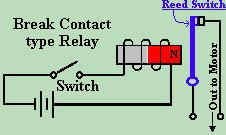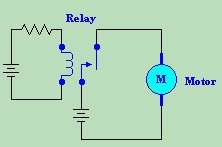

The Relay Races
Knowing that magnetism and electronics are related is a very important lesson. Just how important will become evident in the next few lessons, as we will be discussing the interaction of electricity and magnetism in greater detail. Let's review some of the things we have learned:

-
We know that when two magnets are brought close enough to each other, they will
have one of two reactions. If their poles are the same polarity, they repel,
or push away from each other. If, on the other hand, their poles are
opposite, they attract, or pull toward each other. This is called the
LAW OF POLES
and it applies (to an extent) to electronics as well as with magnetics.
Note that the electrons from the negative side of a battery will attract toward the positive side, if the two are brought electrically close enough to be allowed to do so. This typically happens by connecting a wire, lamp, or some other electrical device between the two electrical poles.
Does electricity move from positive to negative, or from negative to positive? This is a good time to discuss the fact that because we can not truly see the electrons in motion, but can only study their effects, there are 3 differing schools of thought on this subject, all of which have some merit.
-
1).According to the
CONVENTIONAL THEORY
of electron flow, also known as the FRANKLIN THEORY, or the POSITIVE
CURRENT FLOW theory, electricity flows
FROM POSITIVE TO NEGATIVE.
-
2).According to the
EDISON THEORY
, or the NEGATIVE CURRENT FLOW theory, electricity flows
FROM NEGATIVE TO POSITIVE
-
3). According to the
ELECTROMAGNETIC CURRENT FLOW
theory, electricity, like magnetic lines of force, are free floating in
space, and
PUSH OR PULL WITH EQUAL FORCE IN BOTH DIRECTIONS
. This theory, depending on the amounts of negative and positive energy,
and the electrical proximity of the components between them, gives merit to
either of the two above theories.

-
Another fact we know is that we can control the polarity of an electromagnet,
by controlling the polarity of the voltage being fed into it. The North pole
of the electromagnet is ALWAYS on the positive side of the battery.

 With this thought in mind, we can control the physical movement of a permanent
magnet, by controlling the voltage going through a given electromagnet. If we
attach a battery to an electromagnet in such a way that it has the opposite
polarity of a nearby permanent magnet, it will pull the permanent magnet closer
to it. If we then swap the wires going to the battery, the electromagnet will
change its polarity, and the permanent magnet will be pushed away from it.
With this thought in mind, we can control the physical movement of a permanent
magnet, by controlling the voltage going through a given electromagnet. If we
attach a battery to an electromagnet in such a way that it has the opposite
polarity of a nearby permanent magnet, it will pull the permanent magnet closer
to it. If we then swap the wires going to the battery, the electromagnet will
change its polarity, and the permanent magnet will be pushed away from it.
If we physically attach the permanent magnet to a plunger, we can control the movement of the plunger in and out using electrical current. In this way, we use electric current to push a button, pull a lever, open or close a valve, or any number of other tasks.
Because magnets attract ferrite based metals, we can also use electricity to control the physical movement of iron. In the examples given to the right, we are using electric current to move a type of reed switch. These are handy for allowing us to use a small amount of current to, for example, turn on a motor which needs a very large amount of current.

-
In the case of the break contact relay, the reed switch inside the relay is
constantly
CLOSED
(meaning connected), allowing current to flow through it. The motor is on all
the time. When we connect the battery to our circuit via the switch, it will
cause the magnet to pull at the iron reed, opening the switch, and turning the
motor off.

-
In the case of the make contact relay, the reed switch inside the relay is
constantly
OPEN
(meaning disconnected), so no current is allowed to flow through it. The
motor is normally turned off. When we connect the battery to our circuit
via the switch, it will cause the magnet to push at the iron reed, closing
the switch, and turning the motor on.

Now would be a good time to show a schematic diagram and picture of a relay. The diagram to the left is an exact duplicate of the make contact relay circuit represented by the above picture. The break contact relay schematic symbol would be similar, except the contacts would be connected. Keep in mind, that not all schematic symbols are standard. You may see variations of schematic symbols over the years, but they will all be understandable and descriptive of the function of the component.
Below is a picture of a relay

